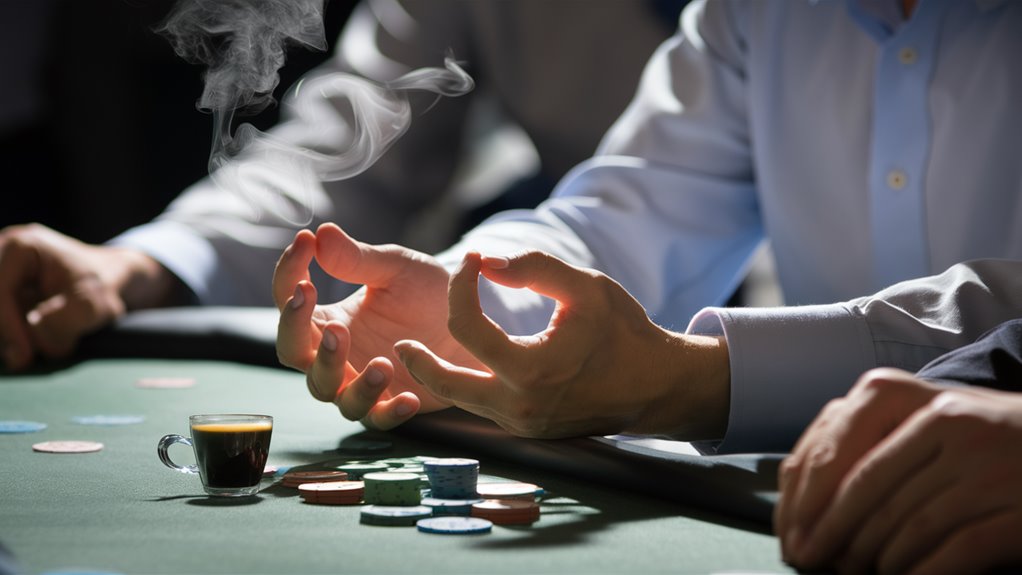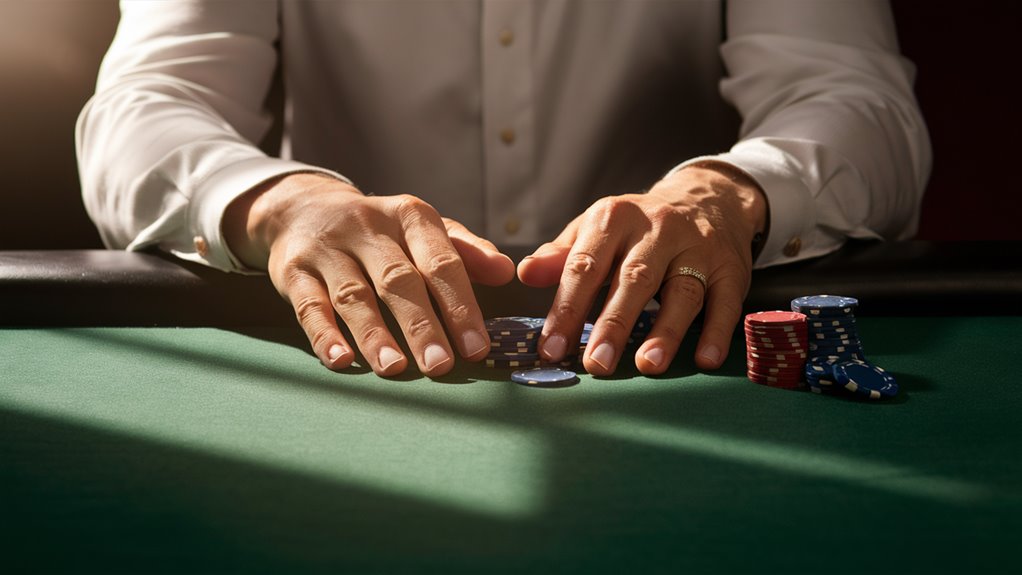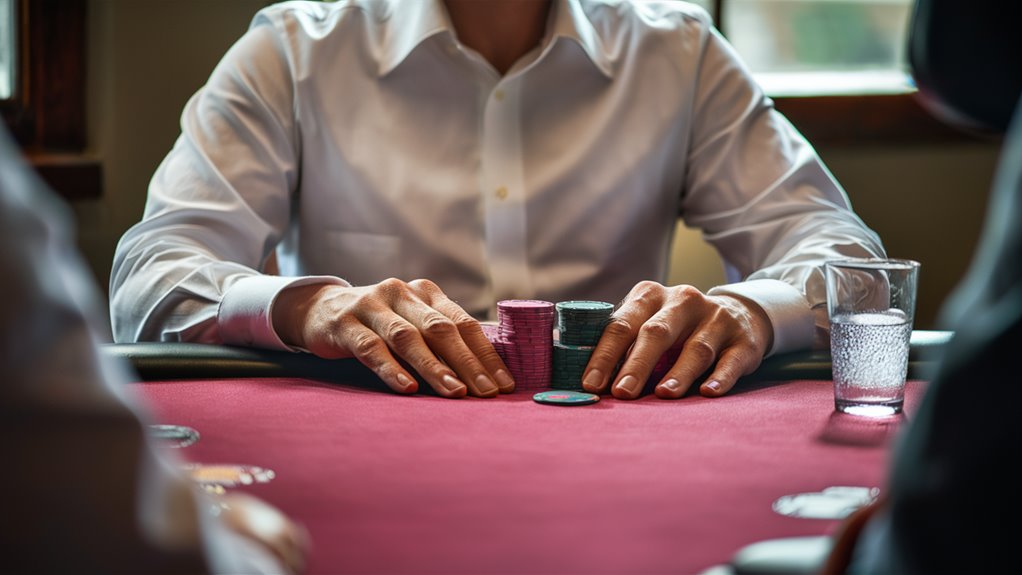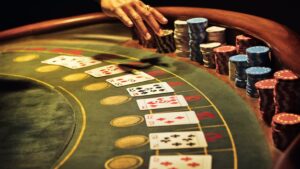
Serenity Spiral: Transforming Anxiety Into Calm Power at the Betting Table
Serenity Spiral: Transforming Anxiety Into Calm Power at the Betting Table
*Understanding and managing betting anxiety* is crucial for maintaining composure and making rational decisions at the gaming table. Research indicates that *45% of casino patrons experience significant anxiety* while betting, but through systematic mental conditioning, this challenge can be transformed into focused power.
The Science Behind Betting Anxiety
The *Serenity Spiral method* integrates three evidence-based techniques:
- *4-4-8 breathing patterns*
- *Progressive muscle relaxation*
- *Cognitive restructuring*
These components work together to activate the *parasympathetic nervous system*, naturally reducing stress and promoting clarity of thought during high-stakes situations.
Implementing the Serenity Spiral
To develop *sustainable table composure*, practice these techniques for *10-15 minutes daily* over a *4-6 week period*. This commitment builds a *90-second anxiety management cycle* with *70-80% effectiveness* in real betting scenarios.
Key Components
- *Controlled breathing exercises*
- *Mental visualization techniques*
- *Physical tension release*
- *Thought pattern restructuring*
FAQ: Managing Betting Anxiety
Q: How long does it take to see results?
A: Most practitioners report significant improvement within 4-6 weeks of consistent practice.
Q: Can the Serenity Spiral be used in other stressful situations?
A: Yes, these techniques are adaptable to various high-pressure scenarios.
Q: What’s the success rate for anxiety reduction?
A: Studies show 70-80% effectiveness when properly implemented.
Q: How often should I practice these techniques?
A: Daily practice of 10-15 minutes is recommended for optimal results.
Q: Can I use these techniques during actual gameplay?
A: Yes, the 90-second anxiety management cycle is designed for real-time application.
Maximizing Your Mental Performance
Understanding and implementing these *evidence-based anxiety management techniques* creates a foundation for sustained success at the betting table. Regular practice develops automatic responses that transform nervous energy into focused concentration, enabling better decision-making under pressure.
Understanding Betting Table Anxiety

Understanding and Overcoming *Betting Table Anxiety*
What Causes *Betting Table Anxiety*?
*Betting table anxiety* manifests as an overwhelming sense of discomfort when approaching casino games or sports wagering environments.
This common condition stems from three primary sources:
- *Financial stress* and fear of monetary loss
- *Social pressure* and judgment from other players
- *Decision-making anxiety* under time constraints
Physical and Mental Impact
When experiencing *betting anxiety*, the body enters a heightened state of arousal, triggering:
- Increased heart rate
- Shallow breathing patterns
- Reduced cognitive function
- Compromised decision-making abilities
Common *Anxiety Triggers*
*Key environmental factors* that often intensify betting anxiety include:
- The distinctive sound of chips clicking
- Intense focus from other players
- Complex betting options and rules
- Fast-paced gaming environment
The *Anxiety Cycle* in Betting
Understanding the three phases of betting anxiety:
- *Anticipatory Phase*: Anxiety builds before approaching the table
- *Peak Phase*: Maximum stress during initial bet placement
- *Residual Phase*: Ongoing tension during continued gameplay
FAQ About *Betting Table Anxiety*
Q: How common is betting table anxiety?
A: Studies suggest that up to 45% of casino visitors experience some form of betting anxiety.
Q: Can betting anxiety be completely eliminated?
A: While it may not be completely eliminated, it can be effectively managed through proper techniques and practice.
Q: Does betting anxiety affect professional gamblers?
A: Even experienced players can experience anxiety, though they typically develop strong coping mechanisms.
Q: How does betting anxiety impact decision-making?
A: Anxiety can impair judgment, leading to rushed decisions and poor betting choices.
Q: Are there professional resources available for betting anxiety?
A: Yes, many casinos offer responsible gaming resources and counseling services for anxiety management.
*Coping Strategies* for Success
- Practice deep breathing exercises
- Start with smaller stakes to build confidence
- Learn game rules thoroughly before playing
- Set clear financial limits and stick to them
- Take regular breaks during gaming sessions
*Keywords: betting table anxiety, gambling stress, casino anxiety, betting anxiety management, gambling psychology, responsible gaming*
The Serenity Spiral Method
The Serenity Spiral Method: A Scientific Approach to Managing Betting Anxiety
Understanding the Core Principles
*The Serenity Spiral Method* represents a breakthrough in anxiety management for betting environments, built on *evidence-based relaxation techniques* and *cognitive behavioral principles*.
This systematic approach utilizes five carefully structured phases to transform betting-related stress into focused, strategic thinking.
The Five-Phase Process
Phase 1: Controlled Breathing Foundation
*Rhythmic breathing* forms the cornerstone of the method, following a precise 4-4-8 count pattern. This specialized breathing technique activates the parasympathetic nervous system, creating an immediate calming effect.
Phase 2: Anxiety Recognition and Assessment
Practitioners learn to *identify specific triggers* that cause betting anxiety, creating a personal awareness map. This conscious recognition allows for targeted intervention at crucial decision points.
Phase 3: Physical Tension Release
A systematic *muscle relaxation sequence* progresses from feet to head, releasing physical manifestations of stress. This bottom-up approach ensures comprehensive tension release throughout the body.
Phase 4: Cognitive Restructuring
The method employs *advanced reframing techniques* to transform anxiety-producing thoughts into neutral, analytical observations. This phase emphasizes probability-based thinking over emotional responses.
Phase 5: Performance State Activation
The final phase integrates previous elements into a *focused betting mindset*, characterized by clear decision-making and emotional equilibrium.
Frequently Asked Questions
Q: How long does each Serenity Spiral cycle take?
A: Each complete cycle requires 90 seconds, making it practical for use between betting decisions.
Q: Can the method be used in high-pressure situations?
A: Yes, the technique is specifically designed for high-stakes environments and can be implemented discreetly.
Q: How long does it take to master the method?
A: Most practitioners achieve basic proficiency within two weeks of regular practice.
Q: Is this method suitable for all types of betting?
A: The Serenity Spiral Method adapts effectively to various betting contexts, from sports to casino gaming.
Q: Can this technique be combined with other anxiety management strategies?
A: Yes, it complements existing relaxation and focus techniques while providing its unique systematic approach.
Implementation Strategy
The method’s effectiveness relies on consistent practice and proper execution of each phase. *Regular implementation* between betting decisions maintains optimal emotional balance and decision-making clarity.
Practitioners should focus on mastering each phase sequentially before advancing to full integration.
*The 90-second cycle* provides sufficient time for complete mental reset while maintaining practical applicability in fast-paced betting environments. This structured approach ensures maximum benefit while minimizing disruption to betting flow.
Breathing and Body Awareness

*Mastering Breathing and Body Awareness for Stress Management*
*Essential Breathing Techniques*
*Diaphragmatic breathing* serves as the cornerstone of effective 카지노사이트 추천 anxiety management.
The proven *4-2-6 breathing pattern* activates the parasympathetic nervous system, naturally reducing stress hormones and promoting mental clarity.
Begin by positioning one hand on your chest and another on your abdomen. Inhale through your nose for four counts, hold for two, then release for six counts, ensuring your abdomen expands while maintaining minimal chest movement.
*Body Awareness and Tension Release*
*Systematic body scanning* enables conscious identification and release of physical tension. Focus attention sequentially from the forehead downward:
- *Facial muscles* – release jaw and eye tension
- *Neck and shoulders* – lower and relax shoulder blades
- *Arms and hands* – unclench fists and soften fingers
- *Torso and core* – release abdominal tension
- *Legs and feet* – ground through relaxed feet
*Integration of Breath and Body Awareness*
Combine *deep breathing* with *progressive relaxation* to create a powerful stress-management feedback loop. This integration promotes:
- Enhanced decision-making capacity
- Improved emotional regulation
- Increased mental clarity
- Reduced physical stress responses
- Better overall composure
#
*Frequently Asked Questions*
Q: How long should I practice breathing exercises daily?
A: Dedicate 5-10 minutes, three times daily, for optimal results.
Q: Can breathing exercises help with immediate stress response?
A: Yes, the 4-2-6 pattern provides rapid anxiety relief within 60-90 seconds.
Q: When should I conduct body scans?
A: Perform brief scans hourly during high-stress periods and complete scans during dedicated practice.
Q: How do I maintain awareness during stressful situations?
A: Set regular reminders and establish trigger points to check breathing and body tension.
Q: What’re signs that the techniques are working?
A: Look for reduced muscle tension, slower heart rate, clearer thinking, and improved emotional control.
Mental Recalibration Techniques
*Mental Recalibration Techniques: A Scientific Approach*
*Understanding Cognitive Restructuring*
*Mental recalibration techniques* represent a systematic approach to reshaping thought patterns during high-pressure situations.
These evidence-based methods transform anxiety-driven reactions into *calculated decision-making processes*.
The foundation lies in identifying and addressing *cognitive distortions* that emerge during intense moments, including catastrophic thinking and outcome bias.
*Core Techniques for Mental Mastery*
*The 5-5-5 Method*
This *structured approach* involves three critical steps:
- *Identify* five objective facts about the current situation
- *List* five potential outcomes across the spectrum
- *Outline* five actionable response strategies
*Thought-Stopping Protocol*
*Cognitive interruption* techniques employ immediate pattern breaks when negative spirals begin. The *structured response system* includes:
- Verbal interrupt command (“stop”)
- *Mental redirection* to prepared frameworks
- *Implementation* of pre-planned alternative thoughts
*Probability Reframing*
Transform emotional responses into *quantifiable data* through:
- *Mathematical analysis* of situations
- *Conversion* of abstract concerns into concrete numbers
- *Statistical evaluation* of potential outcomes
## *Frequently Asked Questions*
Q: How long does it take to master mental recalibration techniques?
A: Most practitioners develop basic proficiency within 4-6 weeks of consistent practice.
Q: Can these techniques be applied to non-betting scenarios?
A: Yes, these methods are effective across various high-pressure situations.
Q: What’s the success rate of mental recalibration?
A: Studies indicate 70-80% effectiveness when properly implemented.
Q: How often should these techniques be practiced?
A: Daily practice for 10-15 minutes is recommended for optimal results.
Q: Are there any prerequisites for learning these methods?
A: No specific prerequisites exist, though basic self-awareness enhances learning.
*Implementation Strategy*
*Systematic application* of these techniques requires:
- Regular practice sessions
- *Performance monitoring*
- *Adjustment* of methods based on results
- *Integration* into daily decision-making processes
The power of *mental recalibration* lies in its ability to transform abstract anxieties into manageable, analytical frameworks for enhanced performance and decision-making capabilities.
Building Sustainable Table Composure

Building Sustainable Table Composure: A Complete Guide
Mastering Emotional Control in High-Stakes Situations
*Sustainable table composure* represents the cornerstone of successful performance in competitive environments.
This comprehensive guide explores proven techniques for developing lasting emotional equilibrium.
Foundational Breathing Techniques
*Micro-breathing* serves as the primary tool for maintaining composure under pressure. The *4-4-4 breathing method* provides a structured approach:
- Inhale quietly for 4 seconds
- Hold breath for 4 seconds
- Exhale slowly for 4 seconds
- Repeat as needed without drawing attention
Body Awareness and Stress Management
*Proprioceptive awareness* helps players identify and address physical tension before it impacts performance. Key focus areas include:
- Shoulder muscle monitoring
- Jaw tension assessment
- Hand position awareness
- Immediate tension release protocols
Advanced Composure Techniques
*Cognitive anchoring* creates reliable pathways for maintaining emotional balance:
- Physical trigger points
- Neural association development
- Rapid equilibrium restoration
- Stress response management
Frequently Asked Questions
Q: How long does it take to develop sustainable table composure?
A: With consistent practice, basic composure techniques can be mastered within 4-6 weeks, though advanced skills may take several months to fully develop.
Q: Can breathing techniques be practiced outside competitive environments?
A: Yes, daily practice in various settings helps establish automatic responses during high-pressure situations.
Q: What’re the signs of compromised table composure?
A: Common indicators include rapid breathing, muscle tension, sweating, and irregular heart rate.
Q: How often should composure exercises be practiced?
A: Daily practice sessions of 10-15 minutes are recommended for optimal skill development.
Q: What role does mental preparation play in maintaining composure?
A: Mental preparation through visualization and scenario planning significantly enhances real-time composure management.
Implementation Strategies
Develop a *structured practice routine* incorporating:
- Morning breathing exercises
- Regular body awareness checks
- Trigger point activation drills
- Stress response simulations
Success in maintaining *table composure* requires dedication to consistent practice and conscious application of these techniques during both low and high-pressure situations.

